|
Archive for the 'anti-Armenianism' Category
Simon Maghakyan on 15 Mar 2008
It is rare when France, the Russian Federation and the United States are part of a small group that vote the same way in the United Nations.
But today they joined the states of Angola, Armenia, India, and Vanuatu in voting against a General Assembly resolution by the Republic of Azerbaijan that calls on Armenian forces to withdraw from the Armenian indigenous region of Nagorno Karabakh – a de facto but internationally unrecognized republic in the ex-Soviet world.
According to Reuters:
The U.N. General Assembly on Friday demanded [on March 14, 2008] that Armenian forces withdraw from all occupied territories in Azerbaijan, but key mediators in the Azeri-Armenia dispute rejected the non-binding resolution.
[…]
There were 100 abstentions and many other countries chose not to participate in the vote, which Western diplomats said was a reflection of the fact that most people felt the Azeri resolution was not a balanced picture of the problem.
“This resolution was not helpful,” said a diplomat from one of the three co-chairs of the Minsk Group — Russia, the United States and France.
The Minsk Group is a committee of countries working to bring about a peaceful resolution of the disagreement over Nagorno-Karabakh, the disputed Caucasus mountain enclave. The group was established by the Organization for Security and Cooperation in Europe (OSCE) in 1992.
A U.S. statement on the resolution said the three Minsk Group co-chairs all voted against the resolution because they agreed it represented a “unilateral” view of the dispute.
[…]
Last week Azeri President Ilham Aliyev said Kosovo’s newly declared independence from Serbia had emboldened Armenian separatists in Azerbaijan’s mountainous enclave of Nagorno-Karabakh.
Both Armenia and Azerbaijan have accused each other of stoking the recent violence there.
The resolution passed by 39 countries voting in favor of Azerbaijan’s ‘territorial integrity,’ while 100 states chose to abstain or not show up at all. The Azerbaijani resolution, which calls for “the immediate, complete and unconditional withdrawal from all the occupied territories of the Republic of Azerbaijan,” was largely voted for by Muslim countries including Armenia’s historic enemy Turkey (where the indigenous Armenian population was eliminated during WWI), Afghanistan, Bahrain, Bangladesh, Iraq, Pakistan, Qatar, Saudi Arabia, Sudan, United Arab Emirates and others. Among others, the ex-Soviet states of Georgia, Moldova and Ukraine – all in somewhat similar situation like Azerbaijan with breakaway regions – supported the resolution. From other former Soviet “Turkic” countries only Uzbekistan supported the resolution while the rest of Central Asian countries voted abstain or were not present. Serbia, which is still protesting the U.S.-backed breakaway of Kosovo, joined Azerbaijan in defending the latter’s “territorial integrity.”
Announcing support for the resolution on behalf of the Organization of the Islamic Conference (OIC), Pakistan’s representative quoted Azerbaijani allegations of “destruction of Azerbaijan’s cultural and historical heritage, including Islamic monuments.” Ironically, Azerbaijan has continuously denied the European Parliament investigation of material heritage destruction in the South Caucasus – raising questions of its sincerity in protecting heritage. And needless to say, Azerbaijan’s rhetoric of “Armenian vandalism” only started in late December of 2005 – after an eyewitness videotape from the Iranian-Azerbaijani border showed servicemen of Azerbaijan’s army reducing the world’s largest Armenian medieval cemetery to dust.
According to the official United Nations website, Armenia’s representative argued that the Azeri-drafted resolution would undermine the peace process and contribute to Azerbaijan’s militant position in dealing with the indigenous population of Nagorno Karabakh:
The representative of Armenia said it was unprecedented for a draft resolution to be put to the vote without there having been any consultations on it, in cynical disregard of the foundation of the United Nations and every other organization. The purpose of the drafters had never been to encourage or facilitate discussion. It was simply a way for Azerbaijan to list its wishes on a piece of paper. If the intention had truly been to contribute to the success of ongoing negotiations, Azerbaijan would have put its energy into the existing Minsk Group negotiation format.
He said that, after Azerbaijan had militarized the conflict 20 years ago, there had been a full-scale war between Armenians of Nagorno Karabagh and Azerbaijan. The result was thousands dead, nearly 1 million refugees and lost territories on both sides. Today, there was a self-maintained ceasefire and negotiations under the auspices of the Minsk Group. Despite that and attempts by Azerbaijan to divert from the peace process, the talks were indeed moving forward. There was now a negotiating document on the table that addressed all fundamental issues, security being foremost among them. The Minsk Group co-chairs had presented the latest version to the two sides at the OSCE Ministerial Meeting in Madrid.
Yet, Azerbaijan risked sabotaging that process by presenting a draft that ignored fundamental international norms and the real issues, which must be addressed, he continued. In short, the draft was counterproductive. It called for the immediate and unconditional withdrawal of armed forces, while ignoring the security vacuum that would result. Who would be responsible for the security of the population of Nagorno Karabagh, which was already vulnerable, in the absence of “international cover” safeguarded by those very armed forces?
The draft also called for self-governance within Azerbaijan, he noted. That had become impossible 20 years ago and was not possible today, when the security of the Armenian minority was clearly endangered. The international community had demonstrated that it understood that, in various conflicts around the world. The Government of Azerbaijan had forfeited its right to govern people it considered its own citizens when it had unleashed a war against them 20 years ago. Armenians would not return to such a situation. Just as victims of domestic violence were not forced back into the custody of the abuser, the people of Nagorno Karabagh would not be forced back into the custody of a Government that sanctioned pogroms against them, and later sent its army against them.
Noting that the draft also asked for commitment by the parties to humanitarian law, he questioned their commitment to the non-use of force, the peaceful resolution of disputes and all the other provisions of the Helsinki Final Act. The draft talked about territories and refugees, but not how the consequences of the conflict would be resolved if the original cause was not addressed. Refugees and territories had been created by an Azerbaijan that had “unleashed a savage war against people it claims to be its own citizens”. Only when the initial cause was resolved would the fate of all the territories and refugees in question be put right.
The draft was a “wasted attempt” to predetermine the outcome of the peace talks, he said. That was not how responsible members of the international community conducted the difficult but rewarding mission of bringing peace and stability to peoples and regions. The co-chairs had found that today’s text did not help the peace talks. Armenia also knew it would undermine the peace process and asked other delegations not to support it.
Simon Maghakyan on 17 Jan 2008
Azerbaijan’s authoritarian president Ilham Aliyev’s recent statement that neighboring Armenia can’t give anything to the world “from the political, economic, transport or cultural points of view” has attracted little attention.
That’s because there is nothing new in a racist statement coming from official Azerbaijan that says Armenia has no cultural contributions to the world. In fact, Aliyev’s regime has done everything possible to prove that point: in December of 2005, the largest Armenian archaeological site in the world – the medieval cemetery of Djulfa – was reduced to dust by a contingent of Azerbaijan’s army. President Aliyev says the destruction never happened because there had never been any Armenia cultural monument in Djulfa in the first place.
And although the deliberate demolition of Djulfa has not attracted much concern from the international community – some suggest the oil factor – there is now a growing concern about Azerbaijan’s ambitions of “uniting Turkic countries” which is usually followed by statements against Armenia and primarily seeks a common identity with the Republic of Turkey.
Mathew Bryza, the Assistant U.S. Secretary of State, has said at a recent conference that “[t]he slogan ‘one nation, two states’ reigning in Turkey and Azerbaijan should be changed. “ Although Bryza’s statement at face is a reference to stopping the common hate toward Armenia it comes amid apparent concerns for growing Pan-Turkism in Eurasia and so creation of a “racial” and possibly Islamic unity.
A recent article in the Eurasia Daily Monitor, titled “The Rebirth of Pan-Turkism?” states:
As the USSR recedes further into history, the post-Soviet Turkic nations of the Caucasus and Central Asia are rediscovering their linguistic and cultural affinities with Turkey, and activists are promoting closer cultural, economic, and political ties.
Among the states of Azerbaijan, Kazakhstan, Uzbekistan, Kyrgyzstan, and Turkmenistan, the pan-Turkic sentiment is most pronounced in Azerbaijan. Azerbaijan’s most ardent support of closer Turkic ties is Nizami Jafarov, director of Baku’s Ataturk Center, a corresponding member of Azerbaijan’s Academy of Science, and head of the Azerbaijani Permanent Parliamentary Commission on the Culture of the Republic of Azerbaijan.
Jafarov’s latest project is setting up a new Turkish language TV channel in Azerbaijan to broadcast to the Turkish-speaking world and foster further integration in the Turkic world. “It is possible to say that this idea has become a reality,” Jafarov said during a recent interview. “The issues of the opportunities, main topics, and language of this TV channel have been defined after long discussions. No one is against the creation of such a channel.” According to Jafarov, the only thing currently lacking is money. “ The issue will be fully elaborated after one of the Turkic countries or any international company undertakes the financing of the TV channel,” but he added optimistically, “I think the issue of the channel opening will be settled this year.”
The concern for Pan-Turkism is not the cultural integration of countries with somewhat closer heritage but old ambitions for a Pan-Turkic “empire” that some scholars believe was the ideology behind eliminating the Armenian people from the Ottoman Empire.
Jafarov is also chairman of the Turkish-Azerbaijani Parliamentary Friendship Group, which has been promoting the idea of closer Turkish-Azeri relations for some time. In 2006 Jafarov maintained, the idea of a Parliamentary Assembly of Turkish States began to gain serious traction, commenting, “Azerbaijan’s suggestion of establishing a Parliamentary Assembly of Turkish States has been approved by all. The format of the Assembly is to be discussed. Creation of this assembly is inevitable. The ongoing processes in the world make it necessary to set up an organization of Turkish states at least on parliament level” (Today.az, February 28, 2006). As envisaged, the Turkish States’ Parliamentary Assembly would consist of delegates from Azerbaijan, Turkey, Kazakhstan, Uzbekistan, Kyrgyzstan, and Turkmenistan.
Although the article fails to directly mention the “role” of Armenia in the Pan-Turkic ambition – that is Armenia would need to be physically annihilated because it is the only country that geographically seperates the Turkic nations – it does reference the anti-Armenian rhetoric of the Pan-Turkic agenda:
An important element of Jafarov’s plan was Armenia’s reaction to such an assembly. The following month Jafarov said, “The Armenian media writes that Turk nations will create a Turanian State and claims that and this state will be against Armenians… The establishment of such an assembly is important for the maintenance of harmony in the world and is not in contradiction with the norms and principles of international law. On the other hand, Armenians are far fewer in number than Turks. There are 100 million Turks in the world and only about 10 million Armenians. Despite this we will discuss the ‘Armenian issue’ after the formation of the Assembly.”
Azerbaijan’s successful destruction of Armenian cultural heritage and an unprecended hate campaign – partially because of losing a recent war to Armenia – toward the people who, even after the Armenian Genocide – stand on the way of Pan-Turkism – has led to convinctions on the part of Azerbaijan’s officials that they should become the leader of the Turkic world:
But the concept has already brushed up against political reality, with both Turkey and Azerbaijan claiming credit for the concept and eventual leadership of the organization. For the Azeris, the recent Congress solidified Azerbaijan’s leadership. According to Nazim Ibrahimov, head of the State Committee on Work with Azerbaijanis Living Abroad, “This congress, which was held on the initiative of President Ilham Aliyev, brought new tone to the Turkish world. In the worldwide Turkish diaspora all Turks are speaking about the congress in Baku. They consider the Azerbaijani President as a new leader of Turkish world” (APA, December 30).
While Azerbaijan’s immense oil wealth gives it a rising presence in the Turkic world, it remains to be seen if that will translate into substantial political power in the Inter-Parliamentary Council and Advisory Council, proposed by Turkey, and whether the heads of the five former Soviet Turkic states will, in fact, be ready to surrender any national sovereignty to such a body. If Azerbaijan and Turkey cannot even agree regarding who provided the impetus for the idea, further integration of the Turkish-speaking world still seems a distant goal.
Armenia’s good relationship with some of the Central Asian “Turkic” countries may also be a factor to the thwart of the political aspect of the Pan-Turkist ambition. Armenian culture is widely spread in many of these former Soviet Union countries and most would disagree with Aliyev’s racist statement that Armenia culturally offers nothing to the world. Moreover, Armenians and Azeris are genetically more related than Azeris and their “Turkic brothers” in Central Asia so hopes for Pan-Turkist racial unity are embedded in myths and prejudice.
Nonetheless, Azerbaijan’s ambitions for greater rule and influence are alarming, as the State Department has finally noticed, even if no one – including Turkey – refuse to participate in the Pan-Turkist agenda. Azerbaijan’s militarization needs to be put to an end. And that must start with activating Section 907 of the Freedom of Support Act.
Simon Maghakyan on 14 Jan 2008
“One cannot accomplish anything without questioning first how an assassin was created from such a baby,” said murdered Turkish-Armenian journalist Hrant Dink’s mourning wife about the teenage boy who killed her husband on January 19, 2007.
Mrs. Dink’s call to illuminate the darkness that created a murderer from a child has inspired Turkish-Norwegian designer Firuz Kutal to draw the cartoon below showing a man with black gasses (aka the nationalist Turkish apparatus) monitoring a photo stand of Hrant Dink being killed.

The murderer, the cartoon suggests, could have been any teenager brainwashed by ultra-nationalist adults. If you look closely, the murderer is making the “Grey Wolves sign” with his left hand, a gesture of fascist Turks who also use the sign in rallies denying the Armenian Genocide. Just like the Turkish kids in this photo from a fascist website:

If you think that the “Grey Wolf” babies are only brainwashed Turkish teenagers, you are mistaken. The babies are being abused since a very young age.
“Abuse” is thought to be physical, but look at these photos:
  (source) (source)
These two little boys are “paying tribute” to the Enver Pasha memorial in Turkey. In case you don’t know who Enver is – he was one of the organizers of the Armenian Genocide. And these two are just one of hundreds of photos of abused kids that Turkish fascists don’t mind posting on their websites.
Here is another one:
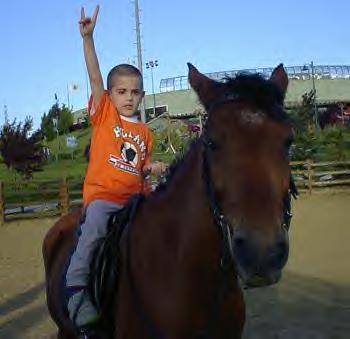
And another:
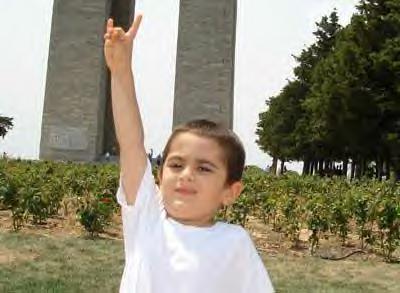
And this baby:
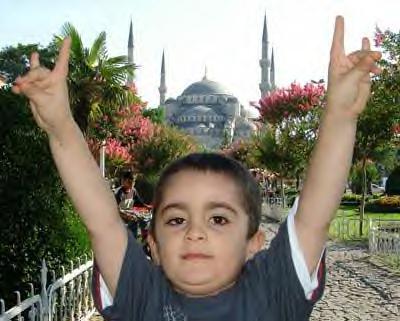
And these kids at a “hero’s” grave:
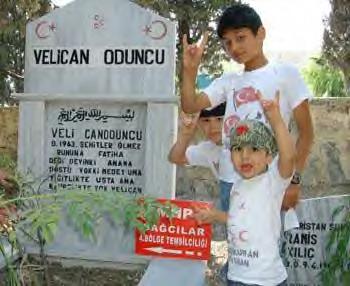
And… kids of nationalist Turks with real guns.
  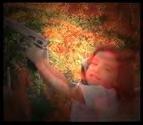
Once Turkish columnist Gökhan Özgün said a YouTube video honoring Hrant Dink’s assassination was worse than child pornography. At that time I was puzzled with Özgün’s words. But after seeing the photos above I think I know what he felt.
Simon Maghakyan on 28 Nov 2007
The alarmist article by the Associated Press that Azerbaijan Defense Minister Hints at War (Nov 27, 2007) is somewhat surprising.

Image: Azeri scientist Kerim Kerimov’s artistic depiction of the possibly upcoming war between Armenia and Azerbaijan from his own website
The long-standing dispute over the Armenian-controlled territory of Nagorno-Karabakh could spark a new war if it remains unresolved, Azerbaijan’s defense minister said Tuesday.
“As long as Azerbaijani territory is occupied by Armenia, the chance of war is close to 100 percent,” Safar Abiyev said during a meeting in Kazakhstan of defense chiefs from ex-Soviet republics.
His startlingly worded remark was a reminder that Azerbaijan has not ruled out use of force in recapturing Nagorno-Karabakh and surrounding areas.
Nagorno-Karabakh and surrounding territory that is also part of Azerbaijan have been controlled by Armenian and ethnic Armenian forces since a shaky 1994 cease-fire ended one of the bloodiest conflicts that followed the collapse of the Soviet Union. The six-year war killed 30,000 people and drove more than 1 million from their homes, including many of the region’s ethnic Azeris.
Azerbaijan and Armenia remain locked in a dispute over Nagorno-Karabakh despite more than a decade of coaxing from international mediators led by the United States, Russia and France to resolve the region’s status.
Gunfire breaks out regularly along the border between Azerbaijan and Armenia and in the regions near Nagorno-Karabakh.
Armenian Defense Minister Mikhail Arutyunian said he sees no alternative to a peaceful settlement, the RIA-Novosti news agency reported.
Surprising in a sense that anyone would be surprised from this conventional militant statement by official Azerbaijan.
Simon Maghakyan on 08 Nov 2007
After having Azeri student Nakhichevan protest about the Harvard exhibit on the destruction of Armenian monuments in Nakhichevan, the U.S. Ambassador, according to an Azerbaijani newspaper (the most credible source in the world), said, “Nakchivan is the territory of Azerbaijan and we will say it all over the world.”
I don’t know where the uninformed nationalists got the idea that cultural protection has to do nothing but territorial claims, but I guess I can make a wild guess why Harvard became “Hayward” in the most credible Azerbaijani newspaper. “Hay” means “Armenian” in Armenian so since there is an exhibit about Armenian monuments (that never existed in the first place) in Harvard it must be Armenianward, whatever “ward” means for Azeri nationalists.
Report from the greatest newspaper in all of tolerant kingdom of Azerbaijan:
 Visiting Historical Monuments, I Understood that Nakchivan is Azerbaijan’s Heart: US Ambassador Visiting Historical Monuments, I Understood that Nakchivan is Azerbaijan’s Heart: US Ambassador
07.11.07 22:17
Azerbaijan, Baku /corr. Trend E.Mammadov / Visiting historical monuments of Nakchivan Autonomous Republic of Azerbaijan, I understood that Nakchivan is the heart of Azerbaijan, said the US Ambassador to Azerbaijan, Anne E. Derse, who is on visit to Nakchivan, on 7 November.According to her, the visits of the US representatives to Nakchivan will actively take place. “Nakchivan is the territory of Azerbaijan and we will say it all over the world,” Derse said.On 1 November an exhibition ‘Armenian monuments in Nakchivan’ took place at Hayward University. The Press Secretary of Azerbaijan Foreign Ministry, Khazar Ibrahim, said that such events adversely affect the negotiations process. National Academy of Sciences of Nakchivan officially stated that there are not Armenian monuments amongst the historical and cultural monuments in Nakchivan.
Visiting historical monuments, huh, Mrs. Ambassador? What about visiting a military camp where an ancient cemetery of thousands of dead existed less than two years ago? Oh, that would be too political.
Simon Maghakyan on 07 Nov 2007
The Azeri Press Agency reports:
 UFO sighted in Nakhchivan UFO sighted in Nakhchivan
[ 18 Oct 2007 12:51 ]
A UFO has been sighted in Nakhchivan Autonomous Republic. APA’s Nakhchivan bureau reports that UFO was observed in Nehrem village of Babek region in the evening on October 15.
The village residents say that the object was clearly seen for several minutes. Some filmed the UFO.
The village residents say that such objects were observed several times before, but unlike the others this time it was nearer. /APA/
According to the same news agency, “A high-level Azerbaijani delegation will leave for the US. We [Azerbaijan] should not stop our propaganda a moment.”
The latter doesn’t concern the UFO but instead lectures by scholars about the destruction of Armenian monuments in Nakhichevan – that, according to Azerbaijan, are lies because Armenians have never lived in Nakhichevan!
But since “Armenian plagiarism…and theft [is] in all fields of human life,” in the words of another Azerbaijani newspaper, the Azerbaijani delegation might as well bring up the issue of UFOs unless it is too late.
Are Armenian UFOs planting ancient graves in Nakhichevan to prove that Armenians once lived there? Who knows!
Simon Maghakyan on 23 Oct 2007

No, I didn’t Google to find the worst possible photograph of Azerbaijan’s authoritarian president who is now warning Armenia with a war if Armenia fails to return Karabakh that the Soviet Leadership had annexed from Armenia to Azerbaijan in the early 1920s.
This photo is from the Armenia Liberty article that talks about Aliyev’s threats:
Azerbaijan will increase its defense spending by nearly one third next year to build up its strength in a long-running territorial dispute with Armenia, President Ilham Aliev said on Monday.
He told a government meeting that the military budget will grow by $300 million to $1.3 billion in 2008.
“The country will allocate funds to buy new hardware, weapons and ammunition, to create a powerful military-industrial complex and improve the professionalism of the military,” Aliev said. “We are creating a powerful army.”
The message of the 45-year-old president was primarily targeted at Armenia, the main backer of Azerbaijan’s breakaway region of Nagorno-Karabakh.
“The insincere behavior of Armenian occupation forces, dragging out the negotiation process, forces us to devote greater attention to military issues,” Aliev said. “Azerbaijan must be ready to liberate its lands by any means.”
[…]
Simon Maghakyan on 05 Oct 2007
Chauvinism or Racism? You decide.
From an Azerbaijani news agency:
| Armenian-like Plagiarism |
04.10.2007
|
Once again, Armenian plagiarism has to be focused on just like it was done numerous times in past, we mean plagiarism and theft in all fields of human life, even starting from the history of separate nations and concerning almost everything. What should be done if theft runs in the blood of Armenians…
In previous issues of our newspaper many times we described unusual Armenian thievish freak – taking lands of neighboring states for their own. But it is just one feature of thievish character of Armenians, though being the first. Representatives of this “great” nation take historical and cultural monuments, articles of folk creation, literature work and art, musical instruments for their own, and if something can’t be taken they simply destroy it…In one word, it is easier to count things not included in the circle of articles of Armenian thievish activity.
Earlier we wrote much about Armenian-like plagiarism in the field of art and music. Unfortunately, it is Azerbaijan that suffers most of all from this Armenian freak. Readers know from our newspaper about attempts of Armenians to take national Azerbaijani musical instruments – tar, kemancha, balaban, zurna for their own; about taking songs of Fikret Amirov “Kor Arabin Makhnisi” (“Song of Blind Arab”), melodies “Vocalis” performed by Brilyant Dadashova for their own; about presentation of Azerbaijani performer, Alikhan Samadov, by Armenian internet-resource armenian-spb.narod.ru, as Armenian musician, and melodies performed by him on balaban as Armenian etc. Apparently this was not enough for miserable thieves. They have touched more prominent persons of Azerbaijani origin and succeeded in presentation of great Azerbaijani composer, Gara Garayev, as Armenian one in the book “Creative Unions: Professional Organizations of Soviet Composers in 1939-1953”, published by Russian teacher of Californian university, historian, Kirill Tomov, as well as in encyclopedia “Britannica”. We wrote about it in our previous issue.
Now other facts of Armenian-like plagiarism have become known. It turned out to be that 8 songs out of 15 in CD “The Art of Armenian Duduk”, released in 2001 belong to Azerbaijani composers but they are presented as Armenian melodies. For example, song “Sene de galmaz” by famous Azerbaijani composer, Tofik Guliyev, is presented in CD under the name “I have a word with a rayer” and Armenian composer Mkrtich Malkhasyan was presented as the author of the said song. Moreover, September 15 of this year in the program of Russian channel ORT “Ice Age”, continuation of TV project “Stars on Ice”, musical accompaniment of the dancing of figure skaters, Sasha Savelyeva (singer from “Fabrika”) and Alexander Sakhnovski (Israeli figure skater, bronze medal winner of World Championship) was the same song of Azerbaijani composer, T. Guliyev, which was presented by their coach Alexander Julin, and presenters of the program, Marat Basharov and Irina Sluzkaya as “Armenian dance”.
You see how “skillfully” Armenian plagiarism is working. A. Julin explained that melody used for dance was proposed to him by the dancing pair he trained, and it is taken from the CD released in America in 1999. CD “ANI” indicates the name of Armenian composer, conductor and performer, Ari Gevorkyan. On the cover of CD one can read that it was released in 1999 in USA by EYE RECORDS. And in CD in which performances of musician A. Samadov were presented as Armenian, song by Alakpar Tagiyev “Sen galmaz oldun” turned into Armenian “You didn’t come”, old Azerbaijani song “Sari galin” into “Blonde bride”, Azerbaijani song “Galmadin” – into “You didn’t come”, Azerbaijani dancing songs “Mirzei” and “Heyva gulu” – consequently to “Mirza” and “Quince flower”.
It is interesting that Armenians didn’t take pains even to change names of the mentioned melodies and simply made translation of their meaning.
Azerbaijani Agency on Copyright applied to the World Organization on Copyright and demanded to investigate the facts of Armenian plagiarism and to take necessary measures against the guilty side. But how long shall we fight against it? Forever? If we take into account the fact that theft runs in the blood of Armenians, then the answer is yes…
|
Simon Maghakyan on 17 Sep 2007
With over 42,397 views in just a day after being posted online, a YouTube video based on a new Turkish song is praising the killing of Armenian-Turkish journalist Hrant Dink.
“Even child pornography is innocent compared to this,” Gökhan Özgün, a columnist for the Turkish Radikal daily, is quoted as saying.
Today’s Zaman, a newspaper from Turkey, reports
A new song by folksinger İsmail Türüt, which covertly praises the men involved in the assassination of Turkish-Armenian journalist Hrant Dink, has caused anger, resentment and grief throughout much of Turkish society.
Three ministries have also taken action following news stories on the ultra-nationalist song that an anonymous fan used to make a video showing Hrant Dink and Father Andrea Santoro, an Italian priest who was killed in the Black Sea region. The Justice Ministry and the Interior Ministry have started an investigation; meanwhile Minister of Culture and Tourism Ertuğrul Günay issued a stern statement, saying he had read the news reports “in horror.” Günay said the government would do everything within its power to make access to the online video clip impossible.
“The song includes intentional cues to fan feelings of hatred and enmity within society,” Günay observed. The Human Rights Association (İHD) called for a boycott of Türüt and announced that it would be filing a criminal complaint against the singer.
“Is it possible for society to function well as long as people who are bold about praising a cowardly and abject murder are respected in various sections of society and have their own television shows?” questioned journalist Ergun Babahan.
[…]
Although the video was produced by a fan, the lyrics of Türüt’s song, written by Ozan Arif, a much-loved poet of the ultra-nationalists, are clearly praising the teenager who shot Hrant Dink on Jan. 17. Türüt denies his song has any racist implications, but references to the names of the teenager and Yasin Hayal, accused of soliciting the hit man, are present in the song — concealed in rather basic wordplay.
The song also makes a clear reference to the Santoro murder. “Stop ringing bells/stop being pro-Armenian/the people won’t swallow that/not in the Black Sea region.” A picture of Father Santoro is shown in the video when Türüt sings the line “Stop ringing bells,” and footage from Dink’s funeral is displayed, in which hundreds of thousands of mourners holding banners reading “We are all Armenian” formed a long procession on the streets of İstanbul. A photo of Dink’s dead body in front of his newspaper Agos is shown as the words of the song “If somebody sells out the motherland/they will immediately die” are being sung.
Meanwhile, Star daily reported that the fan who made the video clip to the song was a Turkish worker living in Vienna.[…]
Simon Maghakyan on 12 Sep 2007
Surprising for a county with such a rich Armenian heritage.
Discrimination body to probe remarks Romanian President made about Armenians
The Associated Press
Published: September 11, 2007
BUCHAREST, Romania: Romania’s anti-discrimination organization said Tuesday it would investigate remarks made by President Traian Basescu to determine whether can be considered defamatory to the Armenian community.
Basescu who underwent surgery at the weekend on his thyroid gland on Sunday thanked doctors at a Bucharest hospital, especially the surgeon saying: “At last I see a kind Armenian, a competent Armenian.”
His remarks were apparently directed at a political rival, Economy Minister Varujan Vosganian, who is an ethnic Armenian and a member of the governing Liberal Party. Vosganian accused Basescu of being blinded by petty political squabbles and called him “a risk for democracy.”
Romania’s politicians from all parties have been embroiled in bitter political disputes for years, especially with the popular president, after no party managed to secure a majority in 2004 parliamentary elections.
Basescu’s office said Tuesday that his remarks had intended to highlight the professionalism of the surgeon who operated on him. “The head of state expresses his appreciation and recognition for the extraordinary contribution that the Armenian community has for years in the cultural and scientific life of Romania,” said Basescu’s spokesman Valeriu Turcan in a statement.
Romania has a few thousand ethnic Armenians who emigrated to Romania 1,000 years ago and are well integrated into society.
In May, Basescu was criticized after he called a reporter “a stinky Gypsy.” The National Council for the Fight Against Discrimination can rule whether Basescu’s remarks amounted to incitement to ethnic hatred or discrimination. LINK
The BBC has more.
« Previous Page — Next Page »
|
|



